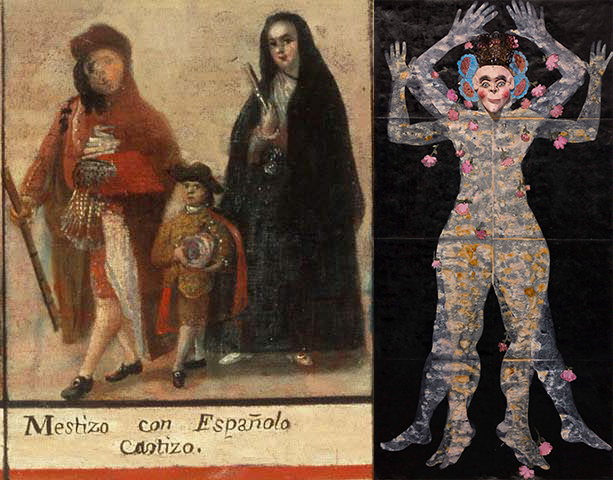


Our summer intern Grace wrote this blog post about the cultural and historical impacts of the casta painting genre referenced in Nancy Friedemann-Sánchez’s paintings in her current exhibition. Casta paintings is a genre popularized in eighteenth-century Spanish Colonial Central and South America that purported to depict a racial and social taxonomy of children born of racially mixed couplings. Friedemann-Sánchez’s contemporary casta paintings take inspiration from this problematic genre to reflect on the legacy of colonialism that lingers in the racial and social discrimination and marginalization present in her home country of Colombia and here in the United States.
As she shared in her essay for the exhibition, Kaylee Lass, the Halsey Institute’s curatorial associate and operations manager says, “Friedemann-Sánchez confronts a racist eighteenth-century genre of painting by Spanish colonizers that endeavored to taxonomize miscegenation and glorify a proximity to whiteness in Latin America. Though used for only a short period in history, the assumptions and terms defined by casta paintings still carry weight in the Americas. The chart-like layout utilized in the genre ‘identified’ sixteen racially mixed families documented in New Spain. The subjects were presented as if they were objects in cabinets of curiosities created for an elite European audience. This fixed system of racial hierarchy determined social and economic class, signaled by the clothes they wore, their domestic environment, and the color of their skin.”
Nancy Friedemann-Sánchez’s current exhibit at the Halsey Institute, Pinturas de Casta and the Construction of American Identity, features her pieces that reference the art historical genre of casta paintings in a unique contemporary style that has not been portrayed in many ways. Therefore, when looking at Friedemann-Sánchez’s artwork, it is essential to know the historical background of casta paintings to better understand the meaning behind her work, which is focused on reflecting colonialism’s legacy of racial and social discrimination in the United States.
Historically casta paintings originated in the 1700s. They are a series of paintings created for the general public of Spain to highlight and show the Spanish citizens at that time the racial diversity and mixing of people in the “New World.” To display what diversification meant to the public, artists often used labels and visual details like different skin tones, dresses, occupations, and settings to differentiate ethnicity and prompt economic and class divisions. The paintings are a meaningful way of showing diverse relationships and neutralizing them. The casta paintings from the 1700s and Friedemann-Sánchez’s version of casta paintings show the realities of discrimination and how much power colonialism has had on viewpoints of race and class.
Images:
Top: (L) Anonymous, Las castas [detail], 18th century, oil on canvas, 148 × 104 cm, Museo Nacional del Virreinato, Tepotzotlán, Mexico. Casta painting showing 16 racial groupings. (R) Nancy Friedemann-Sánchez, Castiza, 2017, ink on Tyvek, Spanish comb, mask, 80 x 40 inches
Middle: Anonymous, Las castas, 18th century, oil on canvas, 148 × 104 cm, Museo Nacional del Virreinato, Tepotzotlán, Mexico. Casta painting showing 16 racial groupings.
Bottom: (L) Anonymous, Las castas [detail], 18th century, oil on canvas, 148 × 104 cm, Museo Nacional del Virreinato, Tepotzotlán, Mexico. Casta painting showing 16 racial groupings. (R) Nancy Friedemann-Sánchez, Mestiza, 2018-2019, ink on Tyvek, Spanish comb, mask, 80 x 40 inches.